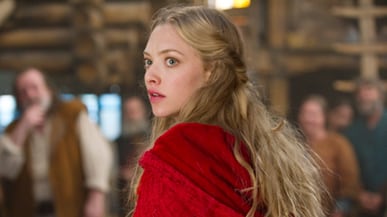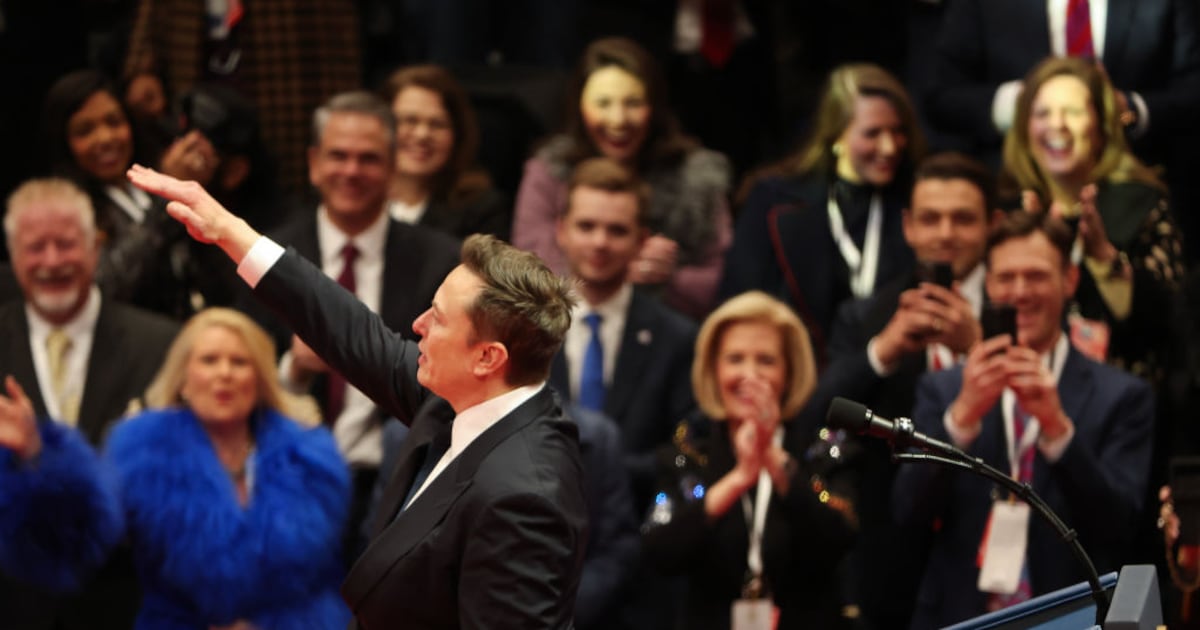You’d be forgiven for mistaking the new movie Red Riding Hood (which hit theaters Friday) for something that it most certainly is not: a romantic thriller in the Twilight vein set against a sexed-up Brothers Grimm backdrop. In fact, marketers have been working overtime in the hopes you’ll presume precisely as much. The logic being that Red Riding Hood’s parts–conflicted heroine caught between brooding hunks, exquisite adolescent longing, arterial splatter–will add up to the same hormonal calculus that propelled the first three Twilight Saga movies to gross $1.8 billion worldwide.
But talk about a wolf in sheep’s clothing.

Shot through with dreadful acting, howl-inducing plot twists, and distracting production design, Red Riding Hood not only manages to underserve its intended teenage girl constituency, it pillages a beloved bed-time story for a tawdry tag-line: “Believe the legend. Beware the wolf.”
The film’s heart-aches and lupine maulings exist in a nowhere land of bad genre clichés (Hot girl-on-girl action! A rave!), quasi-medieval mise en scène and–most bafflingly–emo posturing. Which has resulted in a movie with considerably more violence and less romance than its storybook milieu would have you believe. More problematic still, Red Riding Hood may ultimately end up trashing its director Catherine Hardwicke’s hard-earned credibility as an oracle of adolescent interests–as a filmmaker singularly capable of spinning the libido-driven chaos of budding teens into box-office gold.
Hardwicke, you see, also brought Twilight to the screen, becoming the most successful female director ever in the process. And if there’s an unmistakable Twilight-y whiff to the whole thing, it’s thanks to her pedigree coupled with two none-too-subtle casting maneuvers: Twilight dad Billy Burke plays Red’s father in Red Riding Hood and Shiloh Fernandez, the also-ran who famously came this close to portraying Edward Cullen in The Twilight Saga, appears here as a wolf-battling character named, ahem, Peter.
But where Hardwicke leavened Twilight’s more fantastical vampire elements with pangs of teen yearning (thereby minting Kristen Stewart and Robert Pattinson as international superstars), there’s nary a plausible motive for anything anyone does in Red Riding Hood.
Consider its plot: Red Riding Hood a.k.a. Valerie (Amanda Seyfried), a beautiful maiden with a quiet wild streak, is about to run off with poor woodsman Peter after discovering mom and dad have arranged her marriage to Henry (Max Irons), brood-tastic son of the village’s reigning plutocrat. But Valerie and Peter’s elopement gets the kibbosh when they discover the Wolf–who has kept an uneasy peace with this forest hamlet for generations thanks to regular pig sacrifices–has viciously murdered Valerie’s sister. Eventually famed werewolf hunter Father Solomon (Gary Oldman, who doesn’t so much chew scenery as gnaw entire soundstages to shreds) is enlisted to battle the beast. Bodies pile up while Red finds her heartstrings plucked by the two young studs, either of who would gladly take her hand in marriage. Or more to the point, owing to the fact that every character is potentially a werewolf in Father Solomon’s view, either suitor could as easily bite Red Riding Hood’s hand off in the glare of the full moon.
While all this may sound reasonable enough on paper–it must have at least seemed potentially commercial enough to secure the backing of Leonardo DiCaprio’s production company, Appian Way– Red Riding Hood ends up providing a showcase for no small number of troubling scenes, strange filmmaking choices, and puzzling characterizations (ALERT: SPOILERS ABOUND). Among them:
Not cool, Catherine Hardwicke.
• The movie’s weird, not-quite-but-almost-racist dynamic: Arriving with a platoon of crossbow-wielding minions in heavy chain mail, Father Solomon’s foot soldiers pull off their masks to reveal–gasp!–their surprising ethnicities. Two guards are African-born brothers (whose heavily accented English is never mentioned or explained), one’s an Asian guy with the requisite martial arts skills and a samurai hair style, while the last is a jumpy Latino dude who comes perilously close to stabbing a mentally challenged character in one scene. All the men are lackeys of unflinching obedience. Which is kinda dicey considering they are the film’s only characters of color, contrasting sharply with the mass of Caucasianness and snowy woodlands surrounding them.
• The gratuitous use of same-sex dirty dancing: Father Solomon’s dire warning that the werewolf lives among the townfolk in human form goes inevitably ignored. Instead, everybody decides to engage in a drunken bacchanal that—thanks to music supervisor Brian Reitzell’s electronica-pulsed backing track—comes off like a fairytale version of the rave scene in The Matrix Reloaded. Peter, meanwhile, has decided to spurn Valerie for her own fiscal well-being and starts getting freaky with the village hoochie mama on the dance floor. Incensed by this, Valerie reacts in kind by doing a sort of quasi-Lambada with her homegirl Roxanne. And at one point, you start thinking, What movie is this, Wild Things?—it seems pretty sure that Red and Roxanne are going to kiss.
• A female director using “the male gaze”?: Throughout Red Riding Hood, the camera is constantly creeping up on Amanda Seyfried’s unsuspecting character, lurking behind rockpiles, sneaking surreptitious glimpses of her from around corners, peering down from rooftops and through cracks in buildings–call it the wolf’s eye view. Which is fine and dandy for, say, a slasher movie or a Russ Meyer film. But in a movie intended for young women, the trope seems to implicitly enforce thinking outlined in Laura Mulvey’s groundbreaking 1975 essay “ Visual Pleasures and Narrative Cinema.” That is, that women are more often than not the objects of a heterosexual man’s “gaze” in movies–with a female point of view seldom represented—because most films are directed by and for men. Not cool, Catherine Hardwicke.
• Red Riding Hood's name: "Valerie"?!
But the movie’s most egregious tresspass may be how Red Riding Hood brainwashes teenage girls by sexualizing certain childhood awakenings. In a scene from the film’s third act, Valerie wakes up in her grandmother’s bed and goes through the whole familiar “what big eyes you have” routine with granny en route to the story’s classic “all the better to eat you with!” reveal. This wolf in geriatric clothing set-up is meant in the book to underscore certain timeless themes and enduring truths–the loss of innocence, that familiar faces can conceal hidden agendas, how identity can be fluid vis a vis age and gender (to say nothing of species). But where the fairytale stealthily incepts certain Big Ideas into everyday consciousness, the movie manages to conflate such received childhood wisdom with leering carnal connotations. When the werewolf implores Valerie to “come away” with him lest he destroy her family’s home, the specter of sexual assault comes to mind whether you want it to or not.
Which doesn’t add much value for anyone, let alone members of Red Riding Hood’s core under 25-year-old female demographic, a constituency that’s been casting about for another Twilight, another love story for the ages. Not an exercise in reimagineering everyone’s favorite 700-year-old bedtime story as a sexually sinister exploitation movie.
Chris Lee is a senior entertainment writer for Newsweek/The Daily Beast. He previously worked as an entertainment and culture reporter for the Los Angeles Times. His work has also appeared in Vibe, Premiere and Details magazines and has been plagiarized in The Sunday Tribune of Ireland and The Trinidad Guardian.






